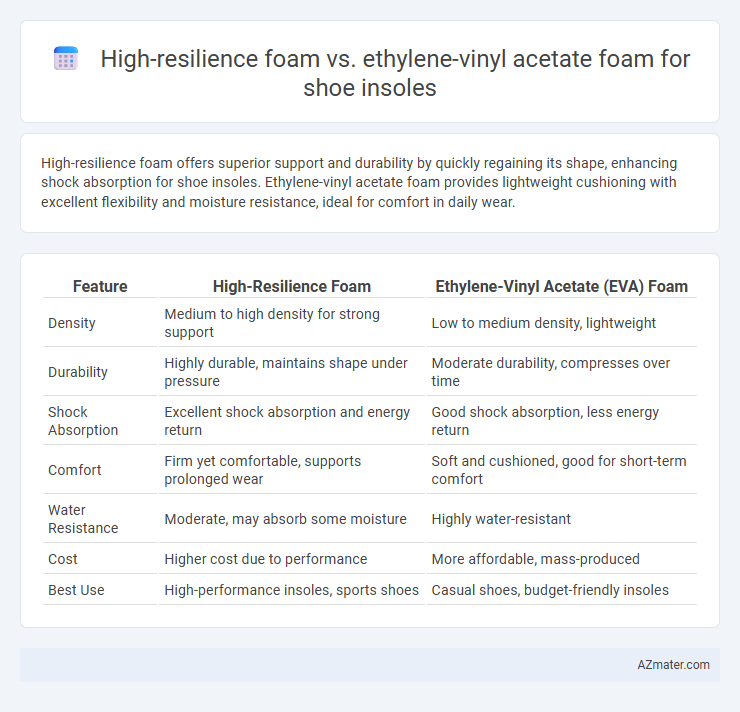High-resilience foam offers superior support and durability by quickly regaining its shape, enhancing shock absorption for shoe insoles. Ethylene-vinyl acetate foam provides lightweight cushioning with excellent flexibility and moisture resistance, ideal for comfort in daily wear.
Table of Comparison
| Feature | High-Resilience Foam | Ethylene-Vinyl Acetate (EVA) Foam |
|---|---|---|
| Density | Medium to high density for strong support | Low to medium density, lightweight |
| Durability | Highly durable, maintains shape under pressure | Moderate durability, compresses over time |
| Shock Absorption | Excellent shock absorption and energy return | Good shock absorption, less energy return |
| Comfort | Firm yet comfortable, supports prolonged wear | Soft and cushioned, good for short-term comfort |
| Water Resistance | Moderate, may absorb some moisture | Highly water-resistant |
| Cost | Higher cost due to performance | More affordable, mass-produced |
| Best Use | High-performance insoles, sports shoes | Casual shoes, budget-friendly insoles |
Introduction to Shoe Insole Materials
High-resilience foam offers superior durability and cushioning by retaining its shape under repetitive pressure, making it ideal for shoe insoles requiring long-lasting comfort. Ethylene-vinyl acetate (EVA) foam provides lightweight, flexible support with excellent shock absorption, commonly used in athletic and casual footwear. Selecting the right insole material depends on performance needs such as impact resistance, weight, and comfort level specific to the footwear application.
What is High-Resilience Foam?
High-resilience foam (HR foam) is a polyurethane foam known for its superior rebound and cushioning properties, offering enhanced durability and energy return in shoe insoles. It features open-cell structure that improves breathability and provides consistent support under repeated compression, ideal for high-impact activities. Compared to ethylene-vinyl acetate (EVA) foam, HR foam delivers greater resilience and comfort, making it preferred for performance footwear requiring long-lasting shock absorption.
What is Ethylene-Vinyl Acetate (EVA) Foam?
Ethylene-Vinyl Acetate (EVA) foam is a lightweight, flexible material commonly used in shoe insoles for its excellent shock absorption and cushioning properties. Its closed-cell structure provides moisture resistance and durability, making it ideal for prolonged wear and high-impact activities. Compared to high-resilience foam, EVA offers superior flexibility and water resistance, contributing to enhanced comfort and foot protection.
Comfort and Cushioning Comparison
High-resilience foam offers superior support and durability for shoe insoles, delivering excellent energy return and long-lasting cushioning that adapts to foot movements. Ethylene-vinyl acetate (EVA) foam provides a lightweight, flexible feel with moderate cushioning, primarily absorbing shock but compressing faster over time compared to high-resilience foam. The comfort level of high-resilience foam is generally higher for prolonged use due to its ability to maintain shape and provide consistent pressure distribution, whereas EVA foam excels in cost-effective, lightweight comfort for everyday casual wear.
Durability and Longevity
High-resilience foam offers superior durability and longevity for shoe insoles due to its ability to maintain shape and support under prolonged pressure and repetitive impact. Ethylene-vinyl acetate (EVA) foam, while lightweight and flexible, tends to compress and degrade faster over time, leading to reduced cushioning efficiency. Therefore, high-resilience foam is preferred for insoles requiring extended wear and consistent performance.
Shock Absorption and Energy Return
High-resilience foam offers superior shock absorption due to its ability to quickly recover its shape after impact, providing consistent cushioning during prolonged activities. Ethylene-vinyl acetate (EVA) foam excels in energy return with its lightweight and flexible structure, which effectively disperses pressure and enhances responsiveness. Both materials improve footwear comfort, but high-resilience foam is preferable for maximum impact protection, while EVA foam optimizes energy efficiency and flexibility.
Breathability and Moisture Management
High-resilience foam offers enhanced breathability due to its open-cell structure, allowing better air circulation and heat dissipation within shoe insoles. Ethylene-vinyl acetate (EVA) foam, while durable and cushioning, typically exhibits lower breathability as its denser composition limits airflow and moisture evaporation. Prioritizing high-resilience foam in insoles improves moisture management by reducing sweat accumulation and maintaining a cooler, drier foot environment.
Weight and Flexibility Factors
High-resilience foam offers superior flexibility and rebound, making it ideal for shoe insoles requiring dynamic cushioning without adding significant weight. Ethylene-vinyl acetate (EVA) foam provides a lightweight option with moderate flexibility, balancing support and shock absorption for everyday footwear. Compared to EVA, high-resilience foam tends to be denser yet delivers enhanced durability and energy return, optimizing insole performance in active or athletic shoes.
Sustainability and Environmental Impact
High-resilience foam offers superior durability and longer lifespan, reducing the frequency of replacement and waste generation, which enhances sustainability in shoe insoles. Ethylene-vinyl acetate (EVA) foam, while lightweight and flexible, is derived from non-renewable petroleum sources and often lacks biodegradability, leading to greater environmental impact during disposal. Choosing high-resilience foam with eco-friendly formulations or recycled content significantly lowers carbon footprint and supports sustainable footwear manufacturing.
Which Foam is Best for Your Shoes?
High-resilience (HR) foam offers superior durability and responsive cushioning, making it ideal for athletic and high-impact shoe insoles. Ethylene-vinyl acetate (EVA) foam is lightweight and provides excellent shock absorption with a softer feel, often preferred for casual or everyday footwear. Choosing between HR foam and EVA depends on your needs for energy return and long-lasting support versus lightweight comfort and flexibility.

Infographic: High-resilience foam vs Ethylene-vinyl acetate foam for Shoe insole
 azmater.com
azmater.com